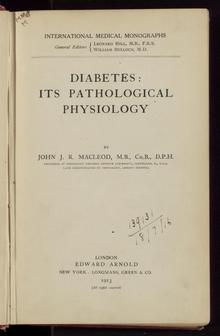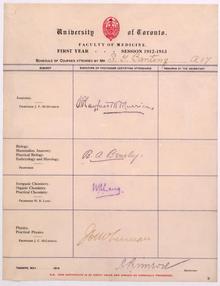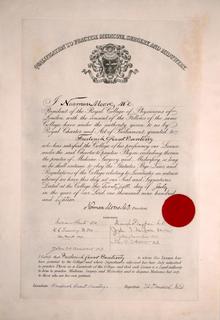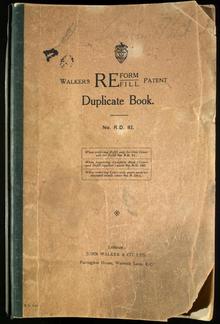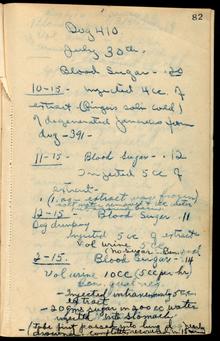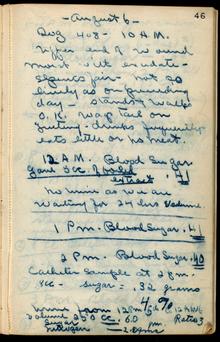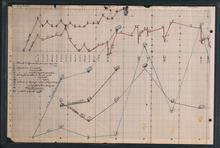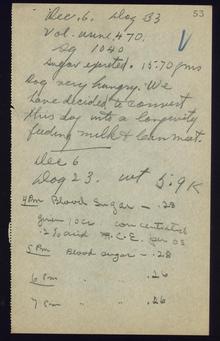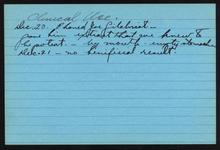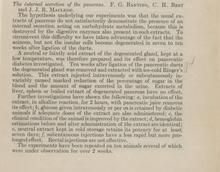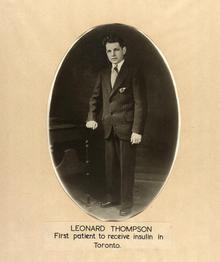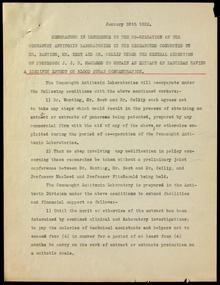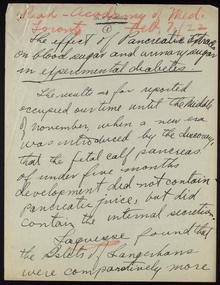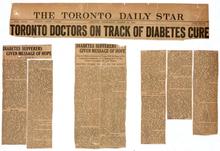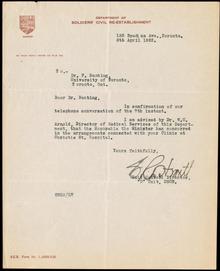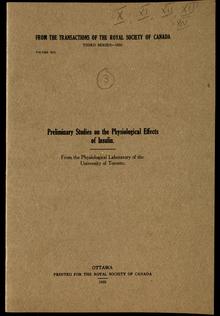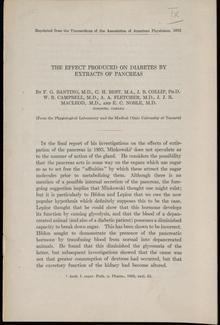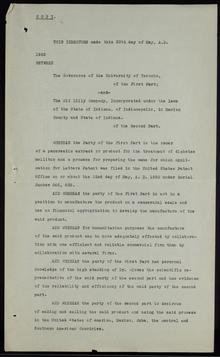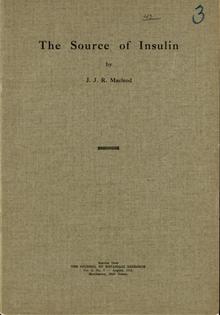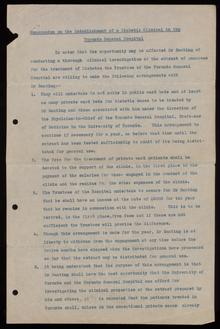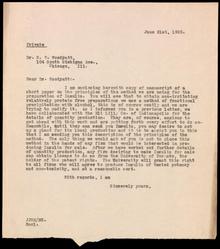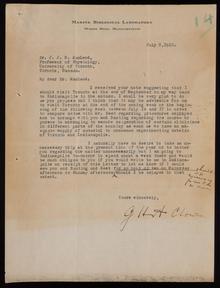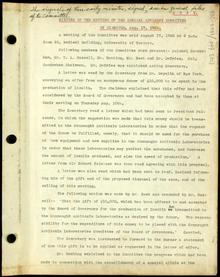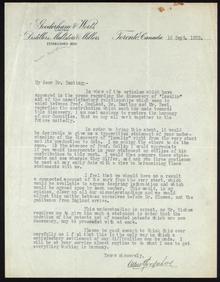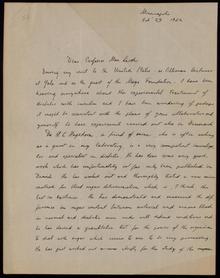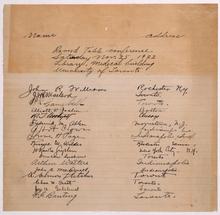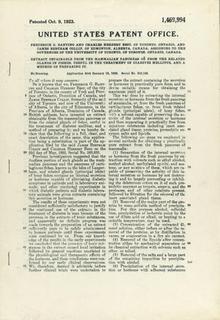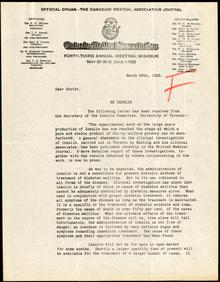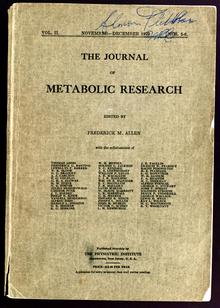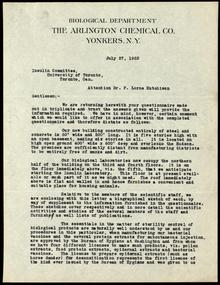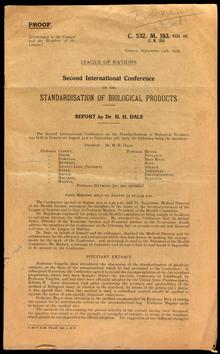Discovery of Insulin at University of Toronto
The discovery of a life-saving treatment for diabetes at the University of Toronto in 1921 made headlines worldwide and was formally acknowledged just two years later when the Nobel Prize for Medicine was awarded to two of the team members. An illustrated timeline of the most significant events that led to the discovery and initial dissemination of insulin is provided here, and the full story with thousands of the original archival documents is available through the UTL's digital special collection entitled The Discovery and Development of Insulin.
1913
John James Rickard Macleod writes a monograph on Diabetes entitled Diabetes: Its Pathological Physiology (London: Edward Arnold, 1913).
1914
The Connaught Antitoxin Laboratory is founded in Toronto by Dr. John. G. FitzGerald.
1916
James Bertram Collip is awarded a Ph. D. in Biochemistry from the University of Toronto.
1916
Charles Herbert Best enters the University of Toronto, he enrolls in the general arts program at University College.
December 1916
Frederick Grant Banting graduates in December 1916 with others from the Class of 1917 in a special session of the University of Toronto Faculty of Medicine.
1918
J. J. R. Macleod invited to be chair of physiology department in Toronto.
July 25, 1918
F. G. Banting awarded certificate from the Royal College of Physicians of London.
October 31, 1920
Banting reads "Relation of the Islets of Langerhans to Diabetes with Special Reference to Cases of Pancreatic Lithiasis" by Moses Barron in Surgery, Gynecology and Obstetrics, Nov. 1920. The article prompts him to jot down a note for an idea for experimentation.
November 6, 1920
F. G. Banting meets J. J. R. Macleod in Toronto for the first time. Macleod later arranges for Banting to use the Physiology Labs at the University of Toronto to try out his idea.
1921
J. B. Collip wins a Rockefeller Travelling Fellowship and returns to the University of Toronto from the University of Alberta in Edmonton.
April-May 1921
April/May. F. G. Banting arrives in Toronto and begins, with Mr. Best on May 17, the experiments which lead to the discovery of insulin at the University of Toronto.
August 4, 1921
Dog 408 receives injection of extract. On August 4th the extract is called "Isletin" for the first time
August 11, 1921
Dog 92, depancreatized, receives regular injections of the extract. Lives for 20 days.
September/October 1921
J. J. R. Macleod returns from Scotland and asks that F. G. Banting and C. H. Best repeat their experiments to confirm their results.
November 14, 1921
F. G. Banting and C. H. Best deliver the first paper on the results of their research to the Journal Club of the University of Toronto Department of Physiology. This paper is later published as "The internal secretion of the pancreas" in the Journal of Laboratory and Clinical Medicine)
November 18, 1921
"Marjorie", November 18. Dog 33 is depancreatized and a longevity experiment begins on December 6th.
December, 1921
J. B. Collip joins Banting, Best, and Macleod and begins insulin experiments with rabbits.
December 20, 1921
Dr. Joseph Gilchrist, a friend of F. G. Banting, is the first human to receive the pancreatic extract manufactured by Banting and Best. It is administered orally and has no beneficial results.
December 22, 1921
J. B. Collip demonstrates that glycogen is formed in the liver of a diabetic dog given pancreatic extract and determines that the extract enables a diabetic liver to function normally.
December 30, 1921
December 30. F. G. Banting, C. H. Best, J. B. Collip, and J. J. R. Macleod attend the annual conference of the American Physiological Society in New Haven. Banting delivers an address entitled: "The beneficial influences of certain pancreatic extracts on pancreatic diabetes". The abstract was published as "The Internal Secretion of the Pancreas" in the American Journal of Physiology, 59 (Feb. 1922).
January 1922
J. J. R. Macleod assembles a team and directs work on the physiological action of insulin. The University of Toronto insulin team now includes: F. G. Banting, C. H. Best, J. B. Collip, J. Hepburn, J. K. Latchford, and E. Clark Noble, under Macleod's direction.
January 11, 1922
The first injection of Banting and Best's extract is given to a hospitalized patient. The injection, given to fourteen year old Leonard Thompson at the Toronto General Hospital, is administered by Ed Jeffrey, the house physician under the supervision of Dr. Walter R. Campbell and Dr. Duncan Graham. The injection has little effect.
January 14, 1922
Press coverage of the discovery begins in Toronto, in a brief article in the Toronto Star Weekly.
January 23, 1922
J. B. Collip's extract is successfully administered to Leonard Thompson at the Toronto General Hospital.
January 25, 1922
Agreement made with the Connaught Anti-Toxin Laboratories for the manufacture of insulin.
February 7, 1922
F. G. Banting and C. H. Best deliver a lecture entitled "The effect of pancreatic extracts on blood sugar and urinary sugar in experimental diabetes" to the Academy of Medicine, Toronto. The paper is published in The Journal of Laboratory and Clinical Medicine, vol. 7, no. 8 (May 1922) as "Pancreatic extracts."
March, 1922
Banting, Best, Collip, Dr. Almon. A. Fletcher, and Dr. Campbell publish "Pancreatic extracts in the treatment of diabetes mellitus" in The Canadian Medical Association Journal. This paper describes the case of Leonard Thompson in detail and constitutes the first official announcement that an extract has been developed which alleviates the symptoms of diabetes in human beings.
March, 1922
Production of insulin fails; no potent insulin is made between March and May of 1922. J. B. Collip, C. H. Best and others work on regaining the formula and Best finally succeeds in May 1922.
March 22, 1922
The first major press coverage of a "diabetes cure" appears in issues of the Toronto Star, Globe, and Telegram. The news quickly spreads beyond Toronto
April-May 1922
A diabetic clinic is established at the Christie Street Veterans Hospital under the direction of Drs. Gilchrist and Banting.
April 3, 1922
Dr. G. H. A. Clowes, Director of Research at Eli Lilly & Co., having been in the audience at the annual conference of the American Physiological Society in New Haven, makes a formal offer to Macleod about the possibility of collaboration for the large-scale production of insulin. His offer is refused.
May 5, 1922
At the annual meeting of the Royal Society of Canada F. G. Banting, C. H. Best, J. B. Collip, and J. J. R. Macleod deliver a series of papers on insulin.
May 1922
Late May. J. B. Collip returns to the University of Alberta and continues insulin experiments there.
May, 1922
C. H. Best is put in charge of the production of insulin for all of Canada at the Connaught Anti-Toxin Labs.
May 3, 1922
Macleod, as spokesman for the whole research group, presents a paper at the Association of American Physicians annual meeting in Washington, D. C. The paper: "The effects produced on diabetes by extracts of pancreas" by Banting, Best, Collip, Campbell, Fletcher, Macleod, and Noble is published in the Transactions of the Association of American Physicians (1922). This was the first widely publicized announcement of the discovery within the medical profession and the first time the extract was referred to in public as "insulin."
May 16, 1922
Insulin made commercially available in Great Britain (the first country in which this is done).
May 22, 1922
Jim Havens, a diabetic patient under the care of Dr. J. R. Williams in Rochester, is the first person in the United States to receive extract.
May 30, 1922
In an effort to manufacture insulin on a large scale an agreement is made between the Governors of the University of Toronto and Eli Lilly & Co. of Indianapolis.
June 1922
J. J. R. Macleod continues to direct experiments on insulin in Toronto and begins research on fish as a source of insulin at the Marine Biological Laboratory in St. Andrews New Brunswick.
June 1922
A Diabetic Clinic is formed in the Toronto General Hospital under the direction of Dr. Duncan Graham. Doctors working in the clinic include: Dr. A. A. Fletcher, Dr. W. R. Campbell, and Dr. F. G. Banting.
June 21, 1922
J. J. R. Macleod sends the insulin formula to Dr. W. D. Sansum in Santa Barbara, California (who had already begun experimenting with the manufacture of insulin) and to Dr. Rollin T. Woodyatt in Chicago. Both doctors begin small-scale production of insulin for clinical and experimental uses.
July 1922
Clinical trials of insulin begin at diabetic clinics in Boston, under Dr. Elliott P. Joslin, and in Morristown, under Dr. Frederick M. Allen. Eli Lilly & Co. supplies the insulin. Soon after, other clinical trials are set up in major cities in the United States and Canada.
July 10, 1922
Mrs. Charlotte Clark, a patient at the Toronto General Hospital, is the first person to receive insulin for surgery.
July 10, 1922
Teddy Ryder, a five-year old diabetic patient from New Jersey, arrives in Toronto for treatment.
August 16, 1922
Elizabeth Evans Hughes, Banting's star patient, arrives in Toronto to be treated.
August 17, 1922
First recorded meeting of the Insulin Committee at the University of Toronto. The Insulin Committee was established by the Board of Governors of the University of Toronto early in 1922 to control the licensing, patenting, and trademarking of insulin as a pharmaceutical product.
September 16, 1922
Col. Albert Gooderham, Chairman of the Insulin Committee, writes to Banting, Best and Macleod soliciting their accounts of the discovery of insulin. They each respond with a written submission.
October, 1922
Elsie Needham is brought back to consciousness from a state of coma with the use of insulin.
October, 1922
August Krogh begins experimenting with and producing insulin in Denmark.
November, 1922
Patent for the manufacture of insulin in Great Britain and Ireland assigned to the Medical Research Council.
November 25, 1922
Prominent diabetic doctors assemble in Toronto to discuss the clinical use of insulin.
December 1922
Canadian patent granted for insulin and assigned, in Jan. 1923, to the Governors of the University of Toronto.
January 23, 1923
United States Patent number 1,469,994 for the manufacture of insulin is awarded to J. B. Collip, C. H. Best and F. G. Banting.
March 28, 1923
Ontario Medical Association sends out a circular about a course of instruction on the treatment of diabetes with insulin being made available to all interested Ontario doctors.
May 1923
A special issue of the Journal of Metabolic Research devoted to articles on the clinical use of insulin is published. This is the first publication of the results of the clinical trials of insulin conducted in diabetic clinics across North America.
June 1923
Exclusive agreement with Eli Lilly & Co. ends. Other pharmaceutical companies are now invited to apply for licenses to manufacture insulin for distribution in the United States and for foreign export licenses. The Insulin Committee begins to collect royalties from pharmaceutical companies on the sale of insulin.
October 1923
Insulin is made commercially available in the United States and Canada.
October 25, 1923
The Nobel Prize in Medicine is awarded to F. G. Banting and J. J. R. Macleod.
1924
Insulin is now widely available; marketed and distributed in countries all over the world by large British and American Pharmaceutical companies.
September 14, 1925
League of Nations Health Committee agrees upon an international standard for determining the potency of insulin.
1926
Insulin is now patented or trademarked in 44 countries world-wide.
1926
Carbohydrate Metabolism and Insulin (London: Longmans Green & Co., 1926) is published by J. J. R. Macleod


